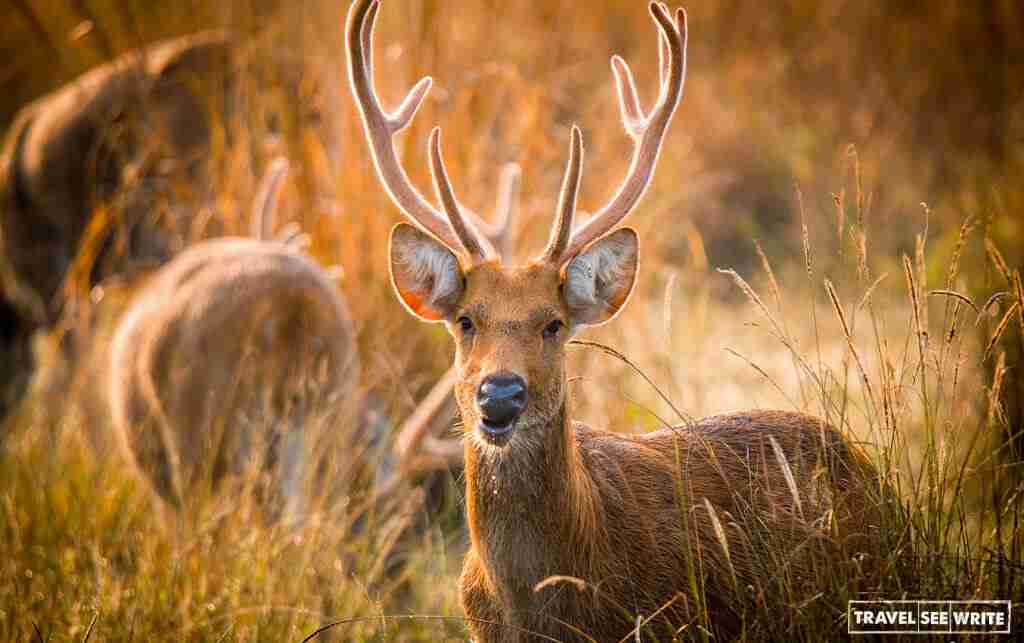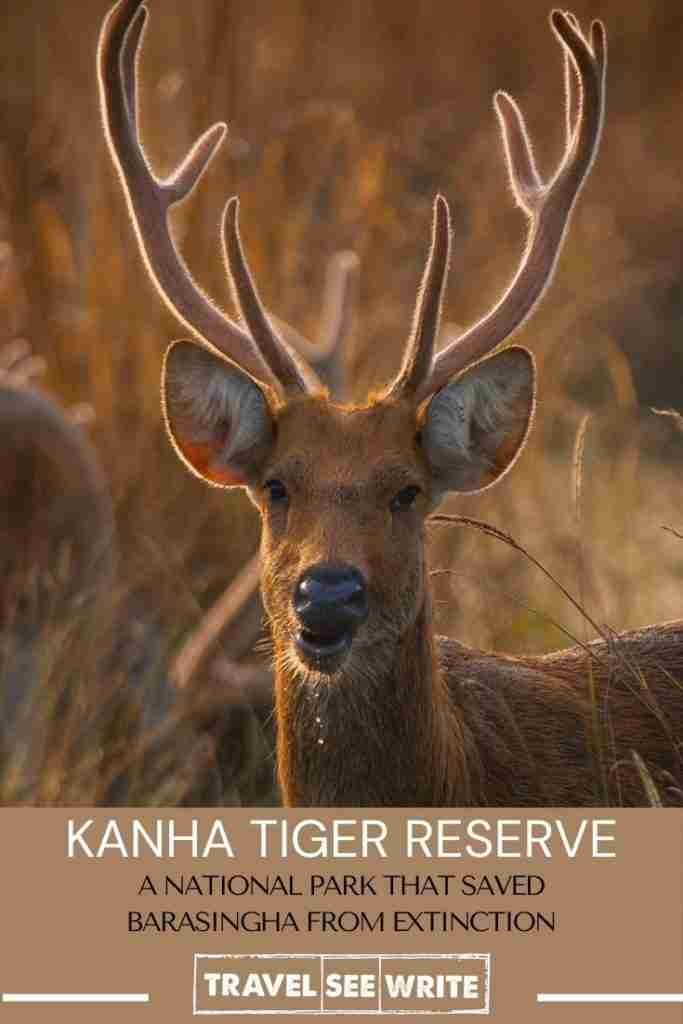When I had planned a two-week-long wildlife jungle safari trip to Madhya Pradesh, I was most excited for Bandhavgarh National Park due to high chances of Tiger sighting there. But my friend, Amit, told me that out of the three national parks (Bandhavgarh, Kanha and Pench) I’ll probably like Kanha Tiger Reserve the most. And boy, was he right!

Why visit Kanha National Park
I can’t tell you how stunning Kanha is. Home to over 1,000 species of plants and about 350 species of birds, Kanha is one the best managed and largest national parks not just in Madhya Pradesh but perhaps in the whole of India. Spread over an area of approximately 2000 sq km it is primarily a moist Sal forest and is dotted with dense groves of vegetation, hillocks and meadows. Of all these habitats, Kanha National Park is famous for its vast meadows that are its lifeline. They sustain a large population of Spotted Deer, Sambar, Barasingha and Gaur, which in turn support predators and co-predators such as Tigers, Leopards, Wild Dogs, Jungle Cats and Foxes.
Kanha Tiger Reserve’s biggest achievement has been the preservation of Barasingha (Hard Ground Swamp Deer) from near extinction. From being just 66 in 1970, today they number more than 800 and are the only surviving population of Barasingha in the wild. For me, sighting “the jewel of Kanha” was far more unforgettable than tiger sighting. The state animal of Madhya Pradesh recently became the park’s mascot, in the form of the character Boorsingh, the Barasingha.
Most people come here in search of Royal Bengal Tigers, but leave having spotted so much more, from rare deer to colossal bison. Here you can really venture deep into the forest for a complete safari experience.
As per recent surveys, Kanha’s sal forests and meadows contain a growing population of around 125 tigers. There are also about 100 leopards and vast populations of deer and antelopes, including southern swamp deer (Barasingha) which exist nowhere else in the world. You’ll see plenty of langurs, Indian bison, wild boars and jackals. Over 260 bird species have been recorded here.
I took two jungle Safaris with my Naturalist Ashu Khan, and every time the jungle seemed so different. The park’s scenery changes dramatically. Swaying sal trees, quiet streams, muddy swamps, bamboo thickets—the landscape unfurls like nature’s own drawing book.
The crisp morning air, the misty earth fragrance, the cold breeze, the sights and sounds of wild animals and birds was the best melody one can hear in the morning hours. On top of that, over two days I had seen plenty to send me chuffed – a parade of barasingha antlers in motion at the crack of dawn, blackbuck grazing in the distance, monkeys and wild boars running from pillar to post, jackals frolicking on the muddy pathways, White-rumped Shama humming melodiously and a family of bison munching on tender leaves was a sight to behold.
Kanha is genuinely mesmerising for all your senses and is one of the richest forests in terms of biodiversity. No wonder termite colonies are the largest in Kanha – almost the size of small hillocks. My forest-encyclopedic Naturalist, Ashu Khan, told me that Termites act as Environmental Bioindicators of the health of a forest and their mounds provide vital clues about the ecology of the region. They are indeed the architects of change.
Besides the wildlife, the park has a mythological connect too – Shravan Tal – a pond immortalised in Ramayana. It’s the spot where King Dashratha (father of Lord Rama) mistakenly killed Shravan (a devoted son of blind parents). Today, its a great place for birdwatching.
Here’s a video showing my experience at Kanha Eco Lodge and Kanha Tiger Reserve.
Travel Tips to have a memorable experience at Kanha Tiger Reserve
Kanha National Park’s location
Located in the heart of India, reaching Kanha National Park takes time and, usually, various modes of transport are available. You can either take a train to Jabalpur (170km away), or fly to the airports at Jabalpur, Raipur or Nagpur, but a road trip will always be there.
Best zones for Safari in Kanha National Park
You can go for a safari in four zones, of which Kisli and Mukki zones are considered best for tiger sightings, followed by Kanha and Sarhi zones.
Kanha National Park Safari booking
Up to 140 four-wheel drive, open Jeeps (mostly Maruti Suzuki Gypsies) are allowed into the reserve per day. Each gipsy is permitted to carry six people along with a driver /naturalist and a guide assigned by the park. You can book your jungle safari online https://forest.mponline.gov.in, up to 120 days in advance. Tickets for 15 4WDs per day can also be purchased in person at the park gates between 6.30 pm to 7.30 pm for the next morning, and 11 am to noon for the same afternoon. But queues can start as early as the previous evening. To avoid any last-minute surprises I booked in advance through my trip organiser – Pugdundee Safaris. Try and book as early as possible, because popular zones sell out months ahead.
How many safaris are enough
No one can predict what you’ll see in each safari but to get a holistic experience of the park, take at least 3-4 safaris. There are two safari slots every day: morning (6 am to 11 am) and afternoon (approximately 3 pm to 6 pm). Morning safaris are longer and tend to produce ore tiger sightings.
Best time to visit Kanha Tiger Reserve
April and May is the best time for tiger spotting, but soaring temperatures make this time of year too hot to handle for many. November to March offers balmy temperatures and a lusher landscape.
Accommodation
While there is no shortage of good resorts and hotels in the vicinity of Kanha National Park, I would highly recommend staying at Kanha Earth Lodge. Located in the fringe of the buffer-zone you feel like you are staying in the greater forest ecosystem and most importantly, its eco-friendly architecture reflects the local landscape and tribal culture. Please read more details about my stay at Kanha Earth Lodge here.
What not to miss
If you have some spare time between jungle safaris and unwinding at your lodge, Kanha Museum is worth a visit. You can learn about the park’s background and landscape with information on the indigenous tribal people who once lived here, but were moved out when the area was made a tiger reserve. In case you are interested in more, there are two other museums located nearby at Mandla – Rani Durgawati Museum and Archeological Museum.
Where to go next
To make the best of your trip, I would highly recommend including the more accessible Bandhavgarh and Pench National Parks. Not only do they reduce journey times but also provide a range of contrasting park experiences.
Over to you now
Kanha Tiger Reserve is one of the best wildlife sanctuaries in India, and I would highly recommend you see. Have you visited the land of Tigers that saved Barasignha from extinction? Have you have visited this park or planning to visit soon? Please share your experiences with us in the comment section below.
Further Reading
- How to successfully plan a Bandhavgarh National Park Safari
- Visiting the Best Wildlife Sanctuaries in India – Bandhavgarh. Kanha and Pench
- Best Jungle Safari in India
- Where to go in 2020: Most famous tourist places state-wise
- Welcome to the circus – Ranthambore National Park
- Hindu BusinessLine: The whole (wild) works
Inspired? Pin these to your Pinterest boards
Disclaimer
Pugdundee Safaris invited me to experience their lodges after COVID19. However, all the views expressed above are my own and based on my personal experiences. Pictures were either shot by Nakul Sharma or me. Please do not copy anything without written permission.

























There is so much more to the National Parks of Madhya Pradesh than just tigers. This post about Kanha amply proves this. What a great success story of conservation the Kanha National Park has achieved, from 66 to 800 Barasinghas is indeed incredible. Your pictures capture the wild beauty of Kanha and bring the place alive. The Kanha Museum too sounds like an interesting place to visit. Your post is surely a very useful guide and ready-reckoner which will come in handy for first-time visitors to Kanha.
This is amazing – I love national parks and observing wildlife – and this one looks particularly exciting. Also, you’ve taken wonderful photos!
Your blog post KANHA NATIONAL PARK: A TIGER RESERVE THAT SAVED BARASINGHA FROM EXTINCTION is informative and attractive due to appealing photos given. Thanks for writing such an informative blog post.
Visiting Kanha National Park would be a dream trip for me! Your photos of the landscape and wildlife are just stunning. I hope to see it for myself up close one day 🙂
That reserve is so amazing. I love the important work that they’re doing. We need more of this in th world.
I would love to tour this reserve with my family. We all love wildlife, and the beauty of nature is something you can never duplicate with any other experience.
This trip looks like it was absolutely incredible. Your photography is amazing and tells the story way beyond your words. Thank you for sharing this.
Wow! I would love to go there and see this all in person. What a gorgeous park.
That reserve is so lovely. I adore what they’re doing to help the animals. I would love to see it in person one day.
Kanha is one of the exotic and beautiful national parks of India. I loved the way you detailed out so nicely about the park, excellent
What a amazing experience you had. Visiting a National Park and saw wildlife animal is adorable. I would love to visit this place.
Kanha Tiger Reserve sounds amazing! I would love to take my family on a trip there one day soon.
After reading this blog with this amazing photos I can visualise the views . I hope to visit this national parks soon…
thanks for posting this amazing blog.